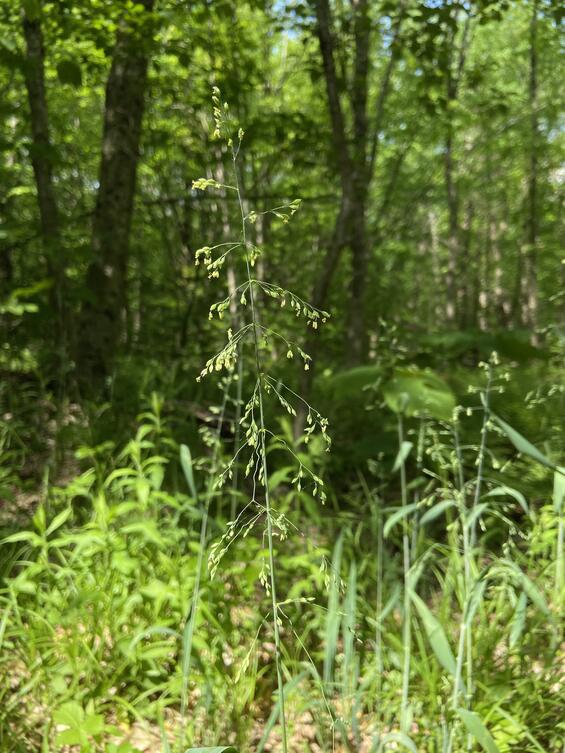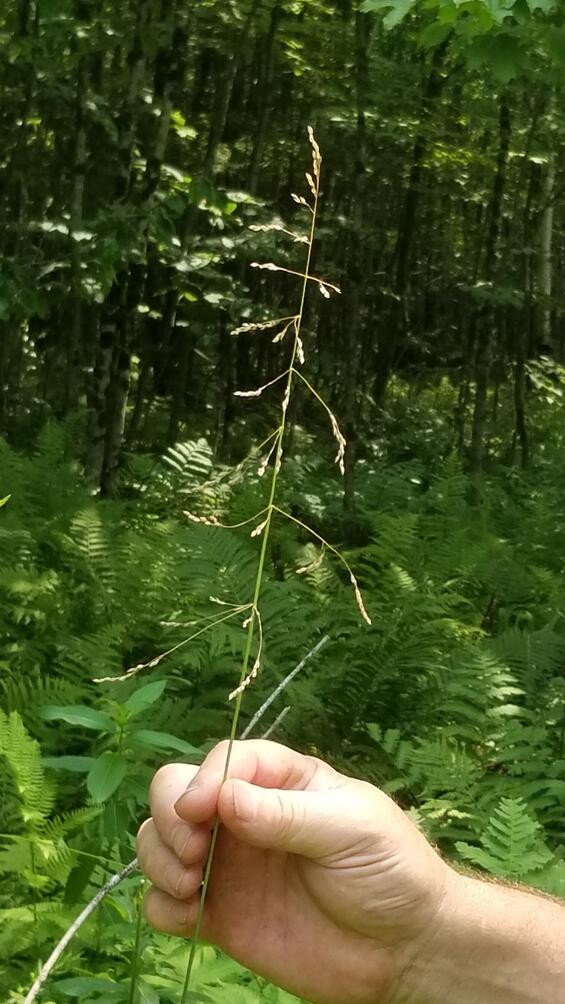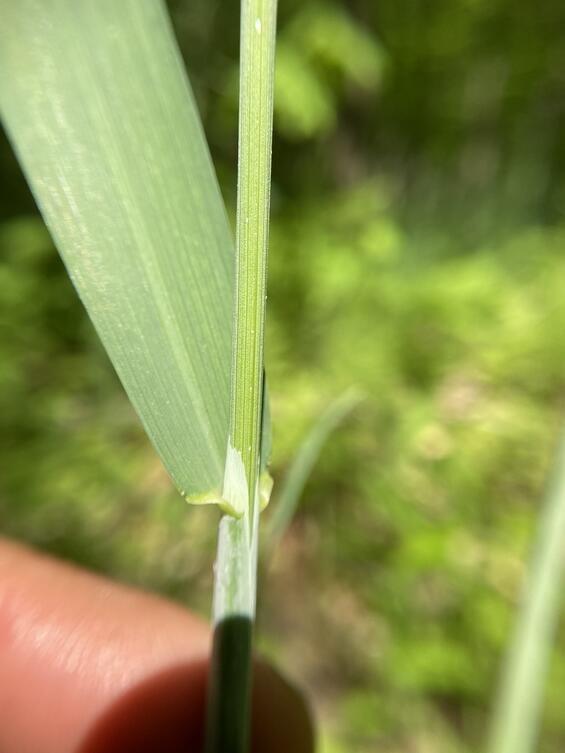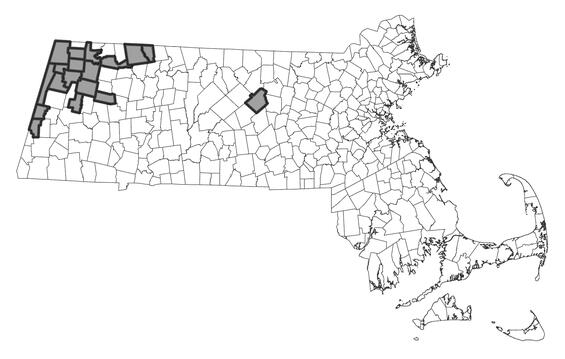- Scientific name: Milium effusum L.
- Species of Greatest Conservation Need (MA State Wildlife Action Plan)
- Threatened (MA Endangered Species Act)
Description
Woodland millet, Milium effusum, is a perennial woodland grass. It has a smooth, somewhat succulent, slender stem that grows 1-1.5 m (3.5-5 ft) tall. The leaf blades are generally 10-20 cm (4-8 in) long and 8-15 mm (0.25-0.5 in) wide. The panicle (flowering part) is sparse looking, 10–20 cm (4-8 in) long with branches which extend outward and carry drooping spikelets. Woodland millet is notable for its delicate pastel bluish-green color and whitish bloom on the stem. Each spikelet contains only 1 floret. To positively identify woodland millet, a technical manual will be helpful.

Milium effusum in habitat. Image by Peter Grima.

Milum effusum seedhead. Image by Karro Frost.

Milium effusum leaf, ligule and glaucous sheath. Image by Peter Grima.
Life cycle and behavior
Woodland millet is a perennial grass species. Typically, the stems appear individually, but it can exhibit clonal growth. Spikelets can be found from late May to September. It is a wind-pollinated species, with pollen that can be dispersed long distances. Its seeds are smooth and ellipsoid, approximately 2-3 mm (0.08-0.11 in) long and 1 mm (0.04 in) wide, and drop near the parent plant. The seeds may be spread by animal ingestion, and sprout from fecal material (King 2019).Woodland millet is a perennial grass species. Typically, the stems appear individually, but it can exhibit clonal growth. Spikelets can be found from late May to September. It is a wind-pollinated species, with pollen that can be dispersed long distances. Its seeds are smooth and ellipsoid, approximately 2-3 mm (0.08-0.11 in) long and 1 mm (0.04 in) wide, and drop near the parent plant. The seeds may be spread by animal ingestion, and sprout from fecal material (King 2019).

Population status
Woodland millet listed under the Massachusetts Endangered Species Act a threatened. All listed species are protected from killing, collecting, possessing, or sale, and from activities that would destroy habitat and thus directly or indirectly cause mortality or disrupt critical behaviors. It has probably never been very abundant in Massachusetts and its rarity is in part related to the relatively few steeply sloped mesic forest communities in the state. Except for one, all populations are small, scattered, and vulnerable to disturbance. Twenty-eight current populations have been documented (1999 to present) in Berkshire, Franklin, Hampshire, and Worcester counties. Three historical occurrences (last observed prior to 2000) have been recorded. Two additional populations are represented only by herbarium records with insufficient information to relocate.

Distribution in Massachusetts. 1999-2024. Based on records in the Natural Heritage Database.
Distribution and abundance
Woodland millet is distributed from Labrador west to Saskatchewan south to North Carolina and west to South Dakota and Iowa. It is considered secure in the central part of its range, while several states and provinces list it as Imperiled or critically imperiled including Connecticut and Massachusetts in New England, Illinois (where it is presumed Extirpated), Indiana, Iowa, and North Carolina. It is also considered imperiled or critically imperiled in Canadian provinces of Prince Edward Island, Labrador, Manitoba, and Saskatchewan. Woodland millet is also known in Eurasia but is a different variety; the North American variety is Milium effusum var. cisatlanticum.
Habitat
Woodland millet is typically found on steep slopes in rich, mesic forest communities with calcareous soils. Its microhabitat often includes the drier, rocky upper slopes of the woodland. Its typical habitat often has a glade-like feel. Commonly associated species include beech (Fagus grandifolia), sugar maple (Acer saccharum), white birch (Betula papyrifera), broad-leaved goldenrod (Solidago macrophylla), wild leek (Allium tricoccum), and broad-leaved sedge (Carex platyphylla). It is occasionally found in flat, swampy areas.
Healthy habitats are vital for supporting native wildlife and plants. Explore habitats and learn about conservation and restoration in Massachusetts.
Threats
Like many rare plant species, specific needs are not fully known. The main threats to woodland millet may include overshading by invasive species or by a dense tree canopy. Logging in forests that support populations may damage a population. Surveyors have noted that development could be a potential risk, as could trail maintenance.
Conservation
Survey and monitoring
Surveys should occur at least every 10 to 15 years as the species does move around. In populations with higher densities, observations should be counted as ramets, not genets. The best time to survey woodland millet is July and August, though fertile florets may be found from May to September.
Management
The specific needs of woodland millet are not known. It is likely that invasive plant species are a problem and will compete with woodland millet, especially in rich mesic forests. All active management of rare plant populations (including invasive species removal) is subject to review under the Massachusetts Endangered Species Act and should be planned in close consultation with MassWildlife’s Natural Heritage & Endangered Species Program.
Research needs
It is not known how long seeds remain fertile in the soil, nor the exact way that seeds can be transported to new sites. Research is needed to determine whether this plant can be grown in a nursery or garden setting for purposes of reintroduction. Questions about seed germination and seed storage over winter will need to be answered.
References
Haines, Arthur. Flora Novae Angliae. New England Wild Flower Society, Yale University Press, New Haven, CT. 2011.
Gleason, Henry A., and Arthur Cronquist. Manual of Vascular Plants of Northeastern United States
and Adjacent Canada, Second Edition. Bronx, NY: The New York Botanical Garden, 1991.
King, Megan. Milium effusum Rare Plant Profile. New Jersey Department of Environmental Protection, Division of Parks and Forestry, New Jersey Forest Service, Office of Natural Lands Management, New Jersey Natural Heritage Program, Trenton, NJ. 2019. 11 pp.
NatureServe. 2025. NatureServe Network Biodiversity Location Data accessed through NatureServe Explorer [web application]. NatureServe, Arlington, Virginia. Available https://explorer.natureserve.org/. Accessed: 1/17/2025.
Contact
| Date published: | May 8, 2025 |
|---|